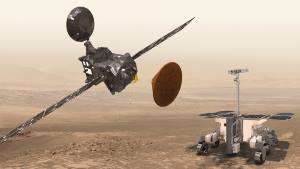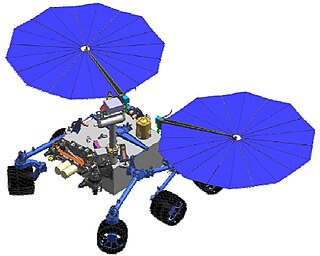| Mission type | Mars impactor |
|---|---|
| Operator | Washington State University |
| Mission duration | At Mars: 10 Sols (≈11 Earth days) |
| Mars impactor | |
The Biological Oxidant and Life Detection (BOLD) is a concept mission to Mars focused on searching for evidence or biosignatures of microscopic life on Mars. [1] [2] [3] [4] The BOLD mission objective would be to quantify the amount of hydrogen peroxide (H
2O
2) existing in the Martian soil and to test for processes typically associated with life. Six landing packages are projected to impact 'softly' on Mars that include a limited power supply, a set of oxidant and life detection experiments, and a transmitter, which is able to transmit information via an existing Mars orbiter back to Earth. The mission was first proposed in 2012. [5]
The Viking program to Mars was the only mission to date that conducted life-detection experiments. It revealed ambiguous and still controversial results. The mission proponents argue that new findings and hypotheses urge a re-evaluation of the Viking results and a re-evaluation of the evidence for the possible presence of life on Mars in general. [2] Recent and current missions to be launched focus on habitability considerations (e.g., Phoenix, Mars Science Laboratory), but shy away from directly testing for life on Mars, with the potential exception of the ESA ExoMars mission.
The BOLD mission is designed to be less expensive than most current Mars missions as it consists only of a carrier vehicle with 6 probes attached. No orbiter is assumed. Instead the probes take advantage of existing Mars orbiters for communications relay. The number of probes is intended to provide a certain degree of mission redundancy in case some of them do not land successfully or fail.
The scientific objectives of the BOLD mission are: to identify the unknown oxidant in the Martian soil, which was postulated after the Viking program, and to probe whether there is extant life near the Martian surface. In contrast to the Viking mission, which was geared toward finding abundant heterotrophic life on Mars with a global distribution, the BOLD mission is aimed at a more comprehensive search including lithoautrophic and photosynthetic microbes, and a variety of biosignatures. [2]
If selected and funded, the carrier vehicle with the landing probes would be propelled into a circular orbit around Mars. The orbiter would be equipped with a small solid rocket to provide the deceleration required to insert the spacecraft in an entry trajectory that can safely release the probes on the Martian surface. A terrain navigation system, coupled with robust propulsion, potentially permits targeting with precision on the order of meters if required to meet the science objectives. Each probe would have a mass of 59 kilograms (130 pounds) [3] with a science payload of less than 10 kilograms (22 lb). Each of the probes' lander system uses a parachute and a crushable shell behind the heat shield for a 'soft impact' landing. Upon landing, the science instruments at their tips would penetrate up to 30 centimeters (one foot) into Martian regolith, a depth sufficient to conduct accurate scientific measurements. [3] The landing probes will be powered by batteries. The mission duration for each landing probe is anticipated to be 10 sols (10 Martian days). [2]
The envisioned instrument suite on each probe includes: [1] [2]

Astrobiology, formerly known as exobiology, is an interdisciplinary scientific field that studies the origins, early evolution, distribution, and future of life in the universe. Astrobiology considers the question of whether extraterrestrial life exists, and if it does, how humans can detect it.

The Viking program consisted of a pair of identical American space probes, Viking 1 and Viking 2, which landed on Mars in 1976. Each spacecraft was composed of two main parts: an orbiter designed to photograph the surface of Mars from orbit, and a lander designed to study the planet from the surface. The orbiters also served as communication relays for the landers once they touched down.

Viking 1 was the first of two spacecraft sent to Mars as part of NASA's Viking program, landing on July 20, 1976. It was the first successful Mars lander in history. Viking 1 was operational on Mars for 2245 sols. Viking 1 held the record for the longest Mars surface mission of 2307 days or 2245 Martian solar days, until that record was broken by the Opportunity rover on May 19, 2010.

The possibility of life on Mars is a subject of interest in astrobiology due to its proximity and similarities to Earth. To date, no proof of past or present life has been found on Mars. Cumulative evidence suggests that during the ancient Noachian time period, the surface environment of Mars had liquid water and may have been habitable for microorganisms. But, the existence of habitable conditions does not necessarily indicate the presence of life.
A biosignature is any substance – such as an element, isotope, or molecule – or phenomenon that provides scientific evidence of past or present life. Measurable attributes of life include its complex physical or chemical structures and its use of free energy and the production of biomass and wastes. A biosignature can provide evidence for living organisms outside the Earth and can be directly or indirectly detected by searching for their unique byproducts.

In 1976 two identical Viking program landers each carried four types of biological experiments to the surface of Mars. The first successful Mars landers, Viking 1 and Viking 2, then carried out experiments to look for biosignatures of microbial life on Mars. The landers each used a robotic arm to pick up and place soil samples into sealed test containers on the craft.

ExoMars is an astrobiology programme by the European Space Agency (ESA) and the Russian space agency Roscosmos.

Planetary protection is a guiding principle in the design of an interplanetary mission, aiming to prevent biological contamination of both the target celestial body and the Earth in the case of sample-return missions. Planetary protection reflects both the unknown nature of the space environment and the desire of the scientific community to preserve the pristine nature of celestial bodies until they can be studied in detail.

The Astrobiology Field Laboratory (AFL) was a proposed NASA unmanned spacecraft that would have conducted a robotic search for life on Mars. This proposed mission, which was not funded, would have landed a rover on Mars in 2016 and explore a site for habitat. Examples of such sites are an active or extinct hydrothermal deposit, a dry lake or a specific polar site.

A Mars landing is a landing of a spacecraft on the surface of Mars. Of multiple attempted Mars landings by robotic, unmanned spacecraft, ten have had successful soft landings. There have also been studies for a possible human mission to Mars, including a landing, but none have been attempted. Soviet Union’s Mars 3, which landed in 1971, was the first successful Mars landing. As of May 2021, Soviet Union, United States, and China have conducted Mars landing successfully.

The Mars Astrobiology Explorer-Cacher (MAX-C), also known as Mars 2018 mission was a NASA concept for a Mars rover mission, proposed to be launched in 2018 together with the European ExoMars rover. The MAX-C rover concept was cancelled in April 2011 due to budget cuts.

Dirk Schulze-Makuch is a professor at the Center for Astronomy and Astrophysics at the Technical University Berlin, Germany and Adjunct Professor at the School of Earth and Environmental Sciences Washington State University, Pullman, WA. He is best known for his publications on extraterrestrial life, being coauthor of five books on the topic: The Cosmic Zoo: Complex Life on Many Worlds (2017), A One Way Mission to Mars: Colonizing the Red Planet (2011), We Are Not Alone: Why We Have Already Found Extraterrestrial Life (2010), Cosmic Biology: How Life could Evolve on Other Worlds (2010), and Life in the Universe: Expectations and Constraints. In 2012 he published with David Darling Megacatastrophes! Nine Strange Ways the World Could End. In 2013 he published the second edition of his science fiction novel Alien Encounter. Together with Paul Davies he proposed in 2010 exploration of Mars by a one-way trip to the planet.
Interplanetary contamination refers to biological contamination of a planetary body by a space probe or spacecraft, either deliberate or unintentional.

Rosalind Franklin, previously known as the ExoMars rover, is a planned robotic Mars rover, part of the international ExoMars programme led by the European Space Agency and the Russian Roscosmos State Corporation. The mission was scheduled to launch in July 2020, but was postponed to 2022.

Icebreaker Life is a Mars lander mission concept proposed to NASA's Discovery Program. The mission involves a stationary lander that would be a near copy of the successful 2008 Phoenix and InSight spacecraft, but would carry an astrobiology scientific payload, including a drill to sample ice-cemented ground in the northern plains to conduct a search for biosignatures of current or past life on Mars.
The Mars Organic Molecule Analyser (MOMA) is a mass spectrometer-based instrument on board the Rosalind Franklin rover to be launched in August–October 2022 to Mars on an astrobiology mission. It will search for organic compounds in the collected soil samples. By characterizing the molecular structures of detected organics, MOMA can provide insights into potential molecular biosignatures. MOMA will be able to detect organic molecules at concentrations as low as 10 parts-per-billion by weight (ppbw). MOMA examines solid crushed samples exclusively; it does not perform atmospheric analyses.

The Urey instrument, or Urey: Mars Organic and Oxidant Detector was a developmental spacecraft instrument for detecting organic compounds including amino acids.
Signs Of LIfe Detector (SOLID) is an analytical instrument under development to detect extraterrestrial life in the form of organic biosignatures obtained from a core drill during planetary exploration.
Andrew Steele is an astrobiologist at the Geophysical Laboratory at Carnegie Institution for Science. He uses traditional and biotechnological approaches for the detection of microbial life in the field of astrobiology and Solar System exploration. His research has led to discoveries of new forms of carbon in meteorites, new mechanisms of organic synthesis on Earth and Mars, and the presence of water in lunar and Martian rocks. Steele has developed several instrument and mission concepts for future Mars missions and was involved in NASA’s 2011 Mars Science Laboratory mission, as a member of the Sample Analysis at Mars team. He also tested instruments on board the Arctic Mars Analogue Svalbard Expedition in the Arctic.